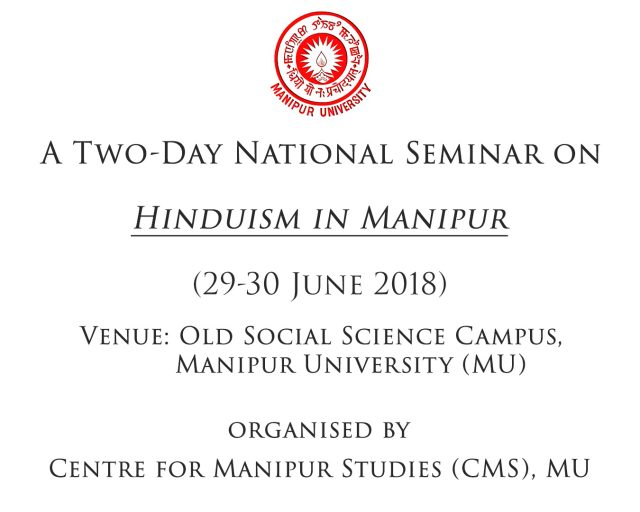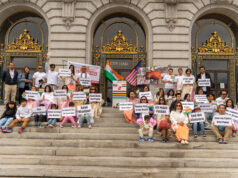2nd June 2018,Imphal :
Concept Note
Hinduism has been followed in Manipur for more than a couple of century and half.The advent of Vaishnavism had been marked by the installation of the image of Vishnu in a temple at Lamangdong by King Kyamba (1467-1508).By mid 18 th Century, more specifically during the reign of Garibniwaj (1709-48), Hinduism was declared as the state religion that was firmly consolidated by the successor kings. Garibniwaj undertook a repressive process of Hinduisations directly challenging the traditional native religious beliefs and practices.In the name of Hinduisation, all kinds of ‘Puyas’(Ancient Manuscripts) collected from nook and Corner of the state under the strict order of the king were consigned to flames in front of the Kangla Uttara in 1789 which is recorded in the annals of the state as ‘Puya Meithaba’.Bengali scripts replaced Meitei scripts. Puyas and works in Meitei scripts were banned. Bengali and Sanskrit languages were patronized.Translation of Hindu epics and religious texts into Manipur was encouraged. Various altars were brought to the ground and many ‘Kopmais’ (Idol masks) of ‘Umanglai’ (Sylvan deities) were buried.Ritual performances of the traditional Meitei deities were taken away from the traditional priests by the Brahmans priests. Hindu calendar with ritual dates was introduced. Protests were displayed against the assertive Hinduisation by the defenders of the old Meitei traditional religion in their individual capacities. But,they failed to organize a collective counter-Hinduisation position.The name of the kingdom known by different names to the different people in different times was given the Hindu name of Manipur.It radically transformed the Meitei society into a new pattern of Hinduised social order.
The glory of Hinduism reached its peak during the reign of Bhagyachandra or Jai Singh (1759-61; 1763-98). He earned the fame of introducing ‘Ras Leela’, the highest spiritual expression of worshipping Krishna in dance form. In contrast to the forced Hinduisation drive of Garibniwaj,Bhagyachandra seemed to have employed rather a soft, yet cautious approach of mass conversion. He introduced institutionalized mechanism of conversion. The Hinduism was subsequently solidified by Gambhir Singh (1825-1834), Nara Singh (1844-50),Chandrakirti(1850-86) and more unceasingly by Raja Churachand Singh ( 1891-1941). The Hinduised system was warmly welcomed in the first half of the nineteenth century by a religious reform movement more specifically during the rule of Churachand Singh. It never posed anti Hinduism or vaisnavite Hinduism in its aesthetics and essence but rather a challenge to ‘superstitious customs’ and malicious practices of the Brahma Sabha under the patronage of Maharaja Churachand Singh. One of the most significant factors,which led to the public fury and the central ideology of the reform movement, was the rampant misuse of religious authority by the Brahma Sabha on the complicated religious issue of ‘Mangba-Sengba’ (Impure and pure).Among the masses, Conversion was carried out by adopting a ritual ceremony called Nongkrang Iruppa which was revered as sacred and holy, followed by Sacred Thread Bearing Ceremony with compulsory recital of ‘Gayatrimantra’.
Almost contemporary to the reform movement, a venture to revive the traditional religion and culture also began under the initiative of Naoria Phullo with the establishment of Apokpa Marup in Cacahar in 1930. There are Scholars like Atombapu, who asserted the existence ofthe prevalence the practice of Vedic religion in the prehistoric period by basing on the affinity of Vedic gods and Meitei deities. Phullo discarded such Aryan-theory of origin of Meiteis.Seeing Hinduism as an exogenous intrusion which had destroyed the traditional religion,identity, culture and ways of life of the Meities, he advocated for unfolding the Meitei identitywith the exposition of the traditional Meitei identity and way of life, worshipping of pure Meitei gods and goddesses and chanting of traditional hymns in Meitei language as liberation from Hindu bondage. However, the revivalist effort doesn’t culminated to the creating a distinct socio-cultural boundary between those who embraced Hinduism and those who continue to follow the native religion. However, those who embraced Hinduism also have not completely abandoned their native faith. Hinduism in Manipur, after coming into contact and having interaction with the native religious elements of rituals, customs and values, etc., have amalgamated and syncretised with it. These syncretisation of Hinduism with the native religious elements had given a distinct and unique identity of Manipuri Hindus as different from the Hindus of mainland India. It made an important contribution to the intellectual life of the people before the introduction of English education in Manipur. Hinduism, in fact had far reaching impact on the contemporary society, language, literature, art and architecture,sculpture and iconography, coins and epigraphy, and music and dance.
Against this backdrop, this seminar intends to address the themes hereunder:
Religious, socio-political cultural and economic life of Pre-Hindu Manipur
State Patronage and Advent of Hinduism in Manipur and its evolution in Manipur.
Local Resistance, religious reform and revivalist movement
Hinduism and syncretisation with the native religious elements
Hinduism and its impact on Contemporary, intellectual life, and culture
Any others related with the theme
Delegate Fee: (Rs. 700 for Faculty and others/ Rs. 500 for Students)
Those desirous of presenting a paper are requested to submit their papers on or before 20 th June to the Office of the Centre for Manipur Studies, MU Old Social Science Campus
Mob: +91-8787685490
or email at : manipurstudiesseminar@gmail.com













LOVE you guys
ILP
Can you please tell us, everyone can join the…..
So this might be how it starts….what we have seen happening all over the country with BJP government…
hoi2 chaokhatnaba twhwro noina napan faringeida.
Topic sud be like ” Rise of Vaishnavism and fall of Sanamahism”.
Y to blame on any religions? When u are aware of humanity. All religions have moral values n teachings. Waste of time debating on which one is the best or worst.
Hindu doesn’t eat beef we do… Coz religion is in other side but we r born with non veg…
Communalism is everywhere in india
Hinduism brought differences among people of manipur.
Hidden propaganda yaohanganu
Yai masi